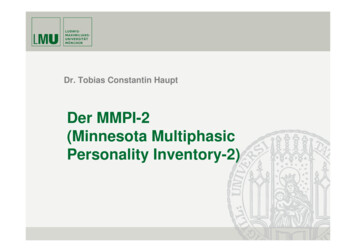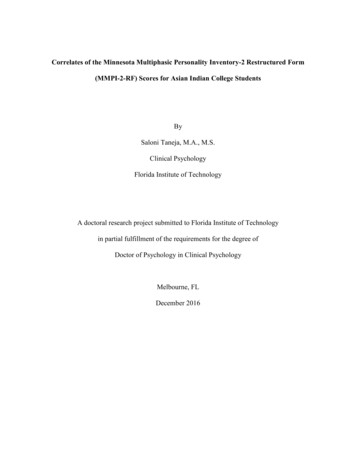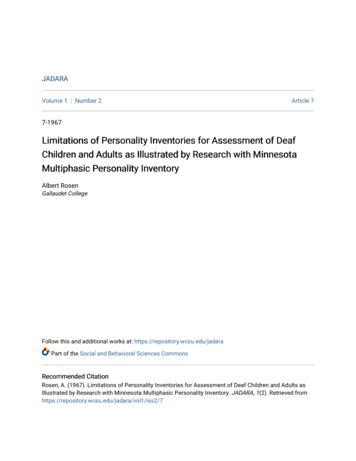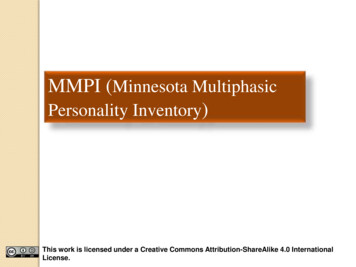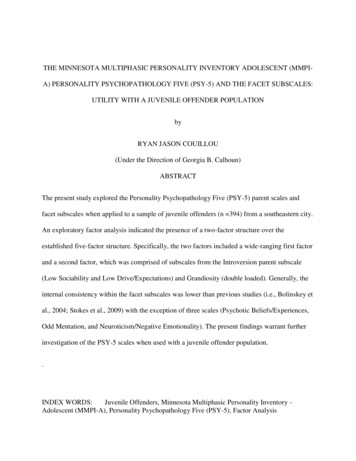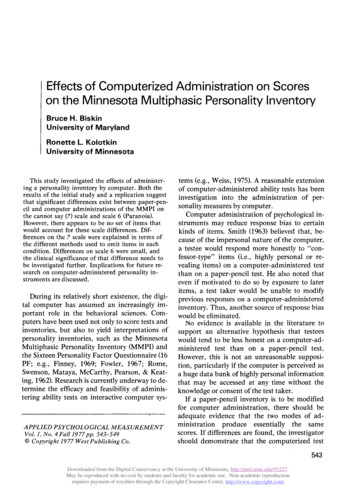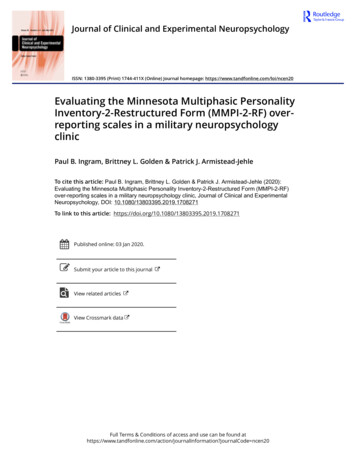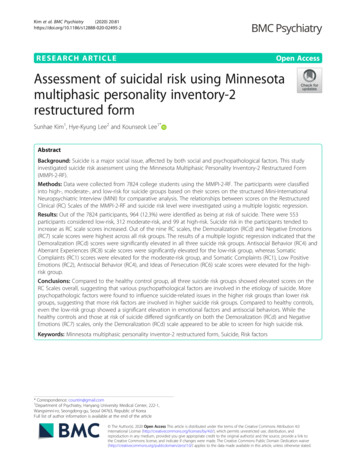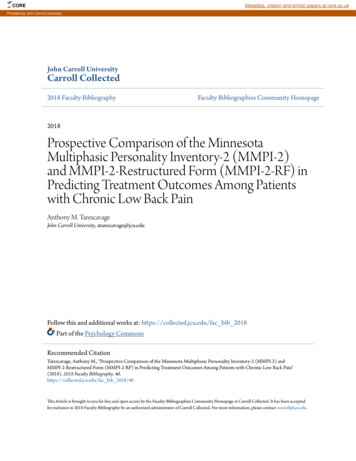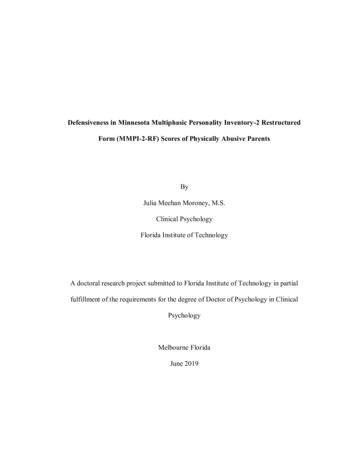
Transcription
Defensiveness in Minnesota Multiphasic Personality Inventory-2 RestructuredForm (MMPI-2-RF) Scores of Physically Abusive ParentsByJulia Meehan Moroney, M.S.Clinical PsychologyFlorida Institute of TechnologyA doctoral research project submitted to Florida Institute of Technology in partialfulfillment of the requirements for the degree of Doctor of Psychology in ClinicalPsychologyMelbourne FloridaJune 2019
We, the undersigned committee, hereby approve the attached Doctoral Research ProjectDefensiveness in Minnesota Multiphasic Personality Inventory-2 Restructured Form (MMPI2-RF) Scores of Physically Abusive ParentsByJulia Meehan Moroney, M.S.Radhika Krishnamurthy, Psy.D., ABAPProfessor, Clinical PsychologyCommittee ChairTravis Conradt, Ph.D.Assistant Professor of PsychologyJohn Lavelle, Ph.DAssociate Professor of Arts and CommunicationLisa Steelman, Ph.D.DeanCollege of Psychology and Liberal Arts
Defensiveness in Minnesota Multiphasic Personality Inventory-2 Restructured Form(MMPI-2-RF) Scores of Physically Abusive ParentsJulia Meehan Moroney, M.S.Major Advisor: Radhika Krishnamurthy, Psy.D., ABAPAbstractThere is a paucity of research on the personality test profiles of physically abusiveparents. Given that personality assessment is typically a major component ofdependency evaluations, the lack of studies in this area represents a significant gap inunderstanding personality-based factors contributing to physical abuse perpetration.Considering research findings of high levels of defensiveness found in profiles ofparents undergoing child custody evaluations, it is reasonable to expect the same forparents involved in substantiated cases of child physical abuse. The current researchwas designed to examine the level of defensiveness in Minnesota MultiphasicPersonality Inventory-2-Restructured Form (MMPI-2-RF) profiles of physicallyabusive parents. Subsequently, the current research aimed to establish optimal cuttingscores for the MMPI-2-RF Restructured Clinical (RC) scales for physically abusiveparents to adjust for defensiveness and denial of personal problems. The centralsample for the study consisted of 62 parents who had a substantiated allegation ofchild physical abuse. This sample was expected to respond defensively via elevatedscores on scales Lie (L-r) and Correction (K-r). This hypothesis was largelyconfirmed, particularly in terms of high L-r scores. It was also hypothesized that RCiii
scale scores would be suppressed for the Physical Abuse sample, which was found forthe majority of RC scales, with some exceptions. The study also employed twocomparison samples: a nonabusive child custody sample (N 64) and a nonabusivecommunity sample (N 61). Comparison between the three groups indicated thePhysical Abuse group was the most defensive, most significantly differentiated by L-r.In keeping with the primary goal of the study, Receiver Operating Characteristics(ROC) analyses were conducted to establish optimal cutting scores for the RC scalesfor physically abusive parents. These were derived from score comparisons of thePhysical Abuse and Community samples. Optimal cutting scores ranged from T 47 toT 59, and were predominantly at or below the MMPI-2-RF normative mean. Theseoptimal cutting scores are intended for use in evaluations to adjust for defensiveresponding among physically abusive parents. Implications of these findings arediscussed.Keywords: MMPI-2-RF, physically abusive parents, child custodyiv
Table of ContentsIntroduction . . 1Review of Literature . . . . 5Characteristics of Physically Abusive Parents . . 5Evaluation of Physically Abusive Parents . . .13Use of Personality Testing in Dependency Cases . . .19Overview of the MMPI, MMPI-2, and MMPI-2-RF . 24Empirical Findings on MMPI-Related PersonalityCharacteristics of Maltreating Parents . . 32Defensiveness in Personality Test Profiles . . . . . 35Measures of Defensiveness on the MMPI, MMPI-2, andMMPI-2-RF. .35Methods of Defensiveness Adjustment on the MMPI, MMPI-2,and MMPI-2-RF . . 40Use of the MMPI K-Correction. 40Derivation of Optimal Cutting scores. . 43Empirical Findings on MMPI-related Defensiveness ofMaltreating Parents . . 46Rationale and Hypotheses . . 52Methods . 55Participants . . . . . 55v
Instruments . . . 61Procedure . . . 63Data Analyses . . . 66Results . . 67Discussion. . 76References. . 85vi
List of TablesTable 1 . 30Table 2 . 56Table 3 . 58Table 4 . 59Table 5 . 67Table 6 . 72Table 7 . 73Table 8 . 74vii
PHYSICAL ABUSE AND MMPI-2-RF DEFENSIVENESS1IntroductionFive-year-old Jessica was in her kindergarten class when her teacher noticedshe was moving slowly and not playing with the other children as she usually did.Complaining of stomach pain, Jessica was sent to the nurse’s office. Upon inspection,the nurse saw deep bruising around her abdomen, and further examination revealedbruises in varying states of healing covering her arms and legs. Jessica’s mother andstepfather had been hitting her with objects and occasionally kicking her aspunishment for behaviors such as leaving toys out or bedwetting. Sadly, cases likeJessica’s are not uncommon. In 2005, physical abuse was the second most frequentlysubstantiated form of maltreatment suffered by children in the United States, and16.6% of United States children have been confirmed victims of such abuse(USDHHS, 2007). This number does not include those children whose abuse has notbeen reported, or whose cases were unable to be substantiated (USDHHS, 2007).Additionally, data from the Child File, a national database that records informationabout child abuse and neglect, has revealed that the younger a child is the more at riskhe or she is for maltreatment (American SPCC, 2016).The welfare of children is of great concern to society. Since the establishmentof the Society for the Protection and Care of Children (SPCC) in 1875, concern forchild wellbeing has been demonstrated through the presence of government-basedchild protection services in every state, such as Florida’s Department of Children andFamilies (DCF) created in 1996. Additionally, this concern can be seen through lawscreated specifically with the intention of protecting children from harm both in the
PHYSICAL ABUSE AND MMPI-2-RF DEFENSIVENESS2immediate future, such as laws regarding child abuse and neglect, and the distantfuture, such as compulsory student education laws requiring children to receiveadequate schooling. Florida Statute 827.03 regarding child abuse and child neglectdescribes physical abuse as a willful act that inflicts physical harm upon a child. It alsoincludes the term aggravated child abuse, which describes a higher level of severity ofsuch an act. The definitions of child abuse as outlined in the statutes of other statesdiffer slightly, although they tend to include a willful act that results in physical harmto a child (Texas Family Code, 2005; New York Penal Law, 2015; Child Abuse andNeglect Reporting Act, 1987).On such occasions where it is determined the child is at substantial risk forfuture harm and needs to be removed from his or her home, the child’s status isdesignated as dependent (Proceedings Related to Children, 2005), that is, under thejurisdiction of the state for appropriate placement and care. The child may be placedwith another relative or sheltered in a foster home until goals for a permanency planare met or parental rights are terminated (Department of Children and Families, 2012).In instances such as these, one or both parents of the child may be required to submitto a psychological evaluation to help determine parental fitness. These evaluationstypically include an interview with each individual, personality assessment, andevaluation of parenting ability. Parents undergoing this process have a great deal atrisk during this time, such as losing their parental rights. Because of this, they often tryto minimize their difficulties and shortcomings in order to appear psychologicallyhealthy and well-adjusted. Impression management such as this is often evident in the
PHYSICAL ABUSE AND MMPI-2-RF DEFENSIVENESS3results of their testing, and is referred to as defensive responding (Bagby, Nicholson,Buis, & Radovanovic, 1999).Defensive responding creates problems in personality assessment as it cancause the results to be invalid or yield less accurate results that limit interpretiveability. For example, defensive responding in personality tests such as the MinnesotaMultiphasic Personality Inventory-2 Restructured Form (MMPI-2-RF) that measurerelatively stable characteristics of a person may yield a profile that is not onlyunrepresentative of the examinee’s way of thinking and behaving, but is also aninaccurate portrayal of his or her psychological adjustment. Profiles that reflect arespondent’s actual psychological health and adjustment are especially important toobtain in evaluations conducted in a legal context due to their contribution to highstakes decisions. Attempts have been made to gauge the level of defensiveness inrespondents’ profiles through the use of validity scales, and some studies have foundthat the use of cutting scores and statistical adjustments can be helpful in adjusting fordefensive responding while simultaneously preserving the interpretive integrity of themeasure. Problematically, however, there is a notable imbalance in the content of themaltreatment-related research, namely that much of the research is centered on childsexual abuse or all types of child maltreatment collectively as a single variable, andphysical abuse-specific literature is markedly absent. The study of physical abuse ishighly important as it is a very consequential issue for children. Children have thepotential to be adversely impacted in many areas of their lives when they sufferphysical abuse, including their physical and mental health, the way they raise their
PHYSICAL ABUSE AND MMPI-2-RF DEFENSIVENESS4own children, their choice of romantic partners, and their likelihood of substance use(Springer, Sheridan, Kuo, & Carnes, 2007). Moreover, basic physical safety isconsidered a human right in the United States, and all vulnerable populations,including children, are entitled to it. Due to the lack of research on such a significantissue, the current study pursued the identification of optimal cutting scores for MMPI2-RF profiles of physically abusive parents in order to adjust for defensive responsepatterns.
PHYSICAL ABUSE AND MMPI-2-RF DEFENSIVENESS5Review of LiteratureCharacteristics of Physically Abusive ParentsResearchers examining why child physical abuse occurs consistently point tothe combination of multiple contributing factors leading to abuse perpetration. Thesefactors often include, but are not limited to, characteristics of the perpetrator, childcharacteristics, perpetrator-victim relationship, cultural practices, and economic stress(Berkout & Kolko, 2016; Herrmann & Martin, 1988; Schnitzer & Weigman, 2005).Attempts have been made to develop abuser typologies based on their sharedcharacteristics, which can be used to more easily assess the interactions betweenabuser characteristics and the aforementioned factors (Francis, Hughes, & Hitz, 1992).The examination of characteristics of physically abusive parents can also aid in earlyidentification, improvement of prevention programs, and improvement of treatmentprograms (Perry, Wells, & Doran, 1983), particularly when considering that abusiveparents may have higher-than-average level of family conflict and low level of familycohesion occurring within their home (Perry et al., 1983; Stith et al., 2009).Studies have shown that physically abusive parents are a heterogeneous groupand vary in personality type and features (Francis et al., 1992), thus necessitating analternative approach, such as identifying subtypes, to understand personality factorscontributing to abusive actions. This was done in a cluster-analytic study by Francis etal. (1992) utilizing the Sixteen Personality Factor Questionnaire (16-PF). Theseresearchers subdivided their sample of physically abusive parents into five groupsbased on 16-PF personality characteristics. The first group consisted of parents who
PHYSICAL ABUSE AND MMPI-2-RF DEFENSIVENESS6were shy, felt guilty and insecure, and tended to isolate themselves from others. Theauthors noted that this cluster reflects a combination of two typologies often found inthe literature with regard to demographic and personality characteristics. This clusterpattern was similar to the findings of Stith and colleagues (2009), in which low selfesteem, depression, psychopathology, childhood abuse, and social isolation werecommon characteristics among physically abusive parents. Additionally, Milner andChilamkurti (1991) had noted from the previous literature that perpetrators have lowself-esteem, which appears to influence parent perceptions of child behavior as well asthe parent’s ability to manage stress, and depression was linked to parent-perpetratedphysical abuse of a child although the nature of that link has yet to be clarified byresearch (Milner & Chilamkurti, 1991). Parents in Francis et al.’s (1992) secondcluster produced personality profiles similar to what is expected for people in thegeneral population. Parents in this group also tended to have higher levels of educationand fewer children. Parents in the third cluster were similar to typologies found in theprevious literature in terms of being socially skilled but compulsive. They tended todeny their pathology and made substantial efforts to present themselves in a favorablelight (Francis et al., 1992). This is concordant with literature that has suggestedperpetrators have an external locus of control and tend to blame their problems onoutside forces such as other people and chance (Milner & Chilamkurti, 1991). Parentswho were classified into the fourth cluster were noted to be compulsive in theirbehavior, and passive and submissive in their relationships with others. The partnersof the parents in this cluster were also often involved in the commission of the abuse.
PHYSICAL ABUSE AND MMPI-2-RF DEFENSIVENESS7Parents in the fifth cluster established by Francis and colleagues (1992) were alsosocially withdrawn and isolated and tended toward tension, suspicion of others, andfeelings of apprehension and frustration. Unlike those of the first cluster, however, theprofiles produced by these parents indicated emotional lability and more severepsychological disturbance than any other cluster in the study. Contrary to the shy,withdrawn type of abuser in this cluster, other studies have found an abuser typewhere perpetrators of physical abuse tend to be more physically and verballyaggressive in interactions with others. Perpetrators who fit into this type also tend tohave more negative interactions with their children but tend to interact less with theirchildren overall compared to nonabusive parents. They turn to physical and punitivemeans of controlling their children rather than reasoning, and tend to perceive thosestrategies as being more effective (Milner & Chilamkurti, 1991).Perry et al. (1983) noted that one of the only gender differences inperpetrators’ psychological characteristics was that the male perpetrators in theirsample did not exhibit lower self-esteem or higher anxiety compared to their nonabusing counterparts in the control group. They hypothesized that their abusivebehaviors may be influenced more by situational and family-related factors, whilerecognizing that personality factors contributing to physically abusive actions may nothave been fully considered in their study. Personality features often seen across studiesinclude rigidity, loneliness, difficulty forming attachment to others, less empathy forothers, more anger and less assertiveness, and higher levels of anxiety (Milner &Chilamkurti, 1991).
PHYSICAL ABUSE AND MMPI-2-RF DEFENSIVENESS8Studies have also attempted to shed light on the role of parenting stress,parenting capacity, and related factors that affect parent-child interactions. Forexample, Berkout and Kolko (2016) conducted a study with a sample of maltreatingparents that specifically examined the effects of parenting stress, negative affect, andpositive parenting behavior using results from factor-specific measures. Their goalwas to determine the effects of various combinations of these factors on thecommission and severity of physical abuse. Using a structural equation model, theresearchers found significant indirect effects of parenting stress on physical abuse.According to their model, parenting stress predicted exacerbation of negative affect,which in turn was related to child-directed aggression. Stith and colleagues’ (2009)findings support this model. They noted abusive parents tended to react more intenselyto child-related aversive stimuli. Whipple and Webster-Stratton (1991) found a similarrelationship between parental stress, negative affect, and physical abuse. In their studyof abusive mothers they noted that those who were experiencing stress and clinicaldepression displayed higher levels of irritability as well as a reduced ability to managetheir negative emotions.Some researchers postulate certain biological factors related to parents’reactions to stress could contribute to their proclivity to abuse their children. Forexample, studies have often found that perpetrators perceived a greater impact ofstress than non-abusers (Perry et al., 1983). This is not to say that abusive parentsnecessarily experience a higher degree of stress compared to non-abusive parents.Rather, it has been suggested that they experience more intense physiological
PHYSICAL ABUSE AND MMPI-2-RF DEFENSIVENESS9reactions to stress compared to nonabusers and lack the psychological resources andresilience to manage their experienced stress (Milner & Chilamkurti, 1991).Specifically, many researchers investigating physiological reactivity posit thatperpetrators of child physical abuse display more intense autonomic reactions to stressand remain autonomically aroused for longer periods of time compared to non-abusers(Milner & Chilamkurti, 1991).A study by Herrmann and Martin (1988) found the age of the child to be asignificant predictor of hospitalization resulting from having been physically abused;specifically, children under the age of 3 were more likely to be hospitalized. Theynoted that the age of the child was not directly responsible for this finding. Rather,they theorized that, in addition to the physical vulnerability of children in this agegroup, more parenting skills are required to manage children of this age group’segocentrism and lack of communicative abilities. Those who are physically abusivemay lack the requisite parenting skills, thereby necessitating examination of parentcharacteristics in addition to other factors. This is consistent with Berkout and Kolko’s(2016) study that found parents who reported physically abusing their children alsotended to report poorer parenting practices overall, such as less involvement with theirchildren, inconsistently following up with consequences, and poorer monitoring ofchild behavior. The authors suggested these parents felt they had fewer methods withwhich they could manage their children’s behavior, and thus resorted to physicallyabusive tactics (Berkout & Kolko, 2016). Many researchers posit that some cognitivedeficits can contribute to child physical abuse by limiting the perpetrator’s ability to
PHYSICAL ABUSE AND MMPI-2-RF DEFENSIVENESS10think flexibly and understand his or her child’s behavior or come up with appropriatebehavior management ideas. Additionally, researchers have hypothesized thatcognitive deficits affecting communication may negatively impact an abuser’s abilityto effectively express their needs and cope with family difficulties (Milner &Chilamkurti, 1991). Studies have also found abusive parents to report experiencing agreater amount of physical maladies compared to non-abusers (as reviewed by Milner& Chilamkurti, 1991). Parents with more physical ailments may be less capable ofeffectively using consistent, nonabusive strategies due to fatigue, pain, and stress fromtheir illnesses.Parental perception of the child’s behavior, rather than the child’s actualmisbehavior, has also been shown to be closely related to perpetration of physicalabuse (Stith et al., 2009). Studies have shown that abusive parents, especially abusivemothers, tend to perceive their children as intentionally disobedient and often viewtheir children more negatively compared to nonabusive parents. Additionally, theytend to ignore positive behaviors and often see negative behaviors as being moreoffensive compared to nonabusive parents (Milner & Chilamkurti, 1991; Stith et al.,2009). Combined with the strength of the relationship between parental anger andhyper-reactivity to stress that has previously been discussed, this finding suggestsparental characteristics play a large part in the perpetration of child physical abuse(Stith et al., 2009). Parental expectations for their children have also been shown to beinfluential. Previous studies have found that abusive parents have unrealistically highexpectations for their children, but more recent literature suggests abusive parents’
PHYSICAL ABUSE AND MMPI-2-RF DEFENSIVENESS11expectations are often inappropriately low regarding some areas and inappropriatelyhigh regarding others (Milner & Chilamkurti, 1991). A study by Perry et al. (1983)found that abusive parents expected their children to reach developmental milestoneslater than normal, contrasting with previous literature suggesting that parents expectchildren to develop more quickly than normal. The abused children in this studytended to display developmental delays, which the authors suggested may haveimpacted the parents’ reported expectations for their children’s development.However, the researchers also hypothesized that some of the abusive parents may haveinfantilized their children, leading to a lack of the requisite support for normal growthand development. Perry and colleagues (1883) posited that child expectations forindependence clashing with parental expectations regarding child development maycontribute to abuse (Perry et al., 1983). These finding emphasize the importance ofcontinuously examining parental expectations and perceptions of children at differentdevelopmental levels.Researchers acknowledge that a substantial amount of studies have focused onparental pathology when analyzing factors that contribute to perpetration of physicalabuse. However, they also emphasize that because abuse occurs within the context ofthe family, family factors are also important to examine (Black, Heyman, & Slep,2001; Stith et al. 2009). Some demographic factors have been linked to negative traitsthat contribute to later perpetration of physical abuse, although these factors are oftendebated amongst researchers (Milner & Chilamkurti, 1991). Research has suggestedthat indicators of lower socioeconomic status (SES) such as lower educational level,
PHYSICAL ABUSE AND MMPI-2-RF DEFENSIVENESS12lower income, and single parent status contribute to the cycle of abuse (Milner &Chilamkurti, 1991). In contrast, Schnitzer and Ewigman (2005) examining instancesof fatal child maltreatment discovered that there was no increased risk to children insingle-parent homes unless an unrelated adult (e.g., stepfather or boyfriend of themother), also lived in the home. In these cases, the risk of death to children under theage of 5 who were dwelling in a home with adults unrelated to them wasapproximately 50 times higher than children who lived with two biological parents(Schnitzer & Ewigman, 2005).Francis et al. (1992) also found variations in education level, number ofchildren in the home, and parental age, suggesting none of these factors are solelyinfluential on the parents’ physically abusive acts (Francis et al., 1992). Furthersupport for this comes from Stith and colleagues (2009) and their finding that theinfluence of parental age is often overshadowed by other mitigating and aggravatingfactors, as well as from Berkout and Kolko’s (2016) finding of no relationshipbetween race and perpetration of physical abuse. Berkout and Kolko (2016) positedthat other variables may be at work, such as lack of resources or negative parentalaffect resulting from perceived racial discrimination. Perry and colleagues’ (1983)study, mentioned earlier, further examined the influence of demographic factors foundamong physically abusing parents, using matched controls. In this study participantswere matched based on social class, one or two parents in the home, age and sex of thechild victimized, age of the parents, number of family members, and birth order of thevictimized child. Perry et al. (1983) found evidence that abusive childhoods did not
PHYSICAL ABUSE AND MMPI-2-RF DEFENSIVENESS13determine abusive behaviors in adulthood, in contrast to the findings of Francis et al.(1992) that suggested an abusive childhood may impact personality factors seen in oneof the abuser subtypes. In studies examining commonalities in cases of maltreatmentrelated fatalities, researchers have found that the biological father was most often theperpetrator, followed closely by unrelated father figures such as stepfathers orboyfriends of the biological mothers (Klevens & Leeb, 2010). Overall, men tended toperpetrate physical abuse significantly more often than women, a finding that isconsistent with previous literature (Damashek, Nelson, & Bonner, 2013; Klevens &Leeb, 2010; Schnitzer & Ewigman, 2005).Evaluation of Physically Abusive ParentsMuch of the research on evaluations of parents who have physically abusedtheir children is embedded within the literature on parental evaluations conductedwithin a range of contexts, including child custody evaluations, dependency cases, andparenting capacity evaluations, where physical abuse has not occurred. Suchevaluations are utilized to aid in treatment planning, assess the efficacy of treatment,screen for signs of maltreatment or adjustment difficulties, confirm report contents,and predict recidivism in instances of maltreatment (Milner & Murphy, 1995). Manypractitioners have found that psychological assessment is necessary in order to screenparents who are considered at risk of maltreating their children, identify those whohave abused their children, and evaluate methods of abuse prevention and intervention(Milner, 1991). Following the confirmation that physical abuse has occurred, the
PHYSICAL ABUSE AND MMPI-2-RF DEFENSIVENESS14parent’s level of risk for recidivism is assessed to determine whether the child is safein his or her care (Milner, 1996).One of many challenges faced by evaluators is in trying to predict futureperpetration of physical abuse when deciding the best interest of the child in terms ofplacement (Milner, 1996). Models aimed at determining why child physical abuseoccurs have been developed to help predict this risk (Milner, 1996). These models canserve to provide a framework within which evaluations are conducted and guideevaluators in their determinations of tools to use in the evaluation, factors present thatcontribute to abuse potential, and questions to answer about the family dynamics.However, researchers are often skeptical that these models possess adequate empiricalsupport to allow them to be in accordance with evidentiary laws (Mart, 2003).Contributing to this is the fact that operationalization of physical abuse has historicallybeen problematic and there is often overlap with other forms of maltreatment inresearch studies (Milner, 1996). This makes it harder to determine risk consistentlyand evaluate risk assessment methods across studies (Milner, 1996).The guidelines set out by the American Psychological Association (2010)regarding child custody evaluations mandate the use of more than one source ofinformation when evaluating parental risk for continued abuse. Such sources includepsychological testing, clinical interviewing, behavioral observation, and a review ofrecords when appropriate. Considering the outcomes of child custody evaluations havehigh stakes, it is critical that psychologists utilize methods that strengthen thereliability and validity of their conclusions (American Psychological Association,
PHYSICAL ABUSE AND MMPI-2-RF DEFENSIVENESS152010). Additionally, some authors have suggested that practitioners conduct multipleevaluations on different dates to account for additional variables that may come intoplay after the first evaluation (Milner, 1996). Although the guidelines of the AmericanPsychological Association are applicable across the country, the precise criteriaconsidered in an evaluation may differ between states. Some examples include theability of the involved parties to meet the basic needs of the child, moral fitness of theinvolved parties, the relationship between the child and involved parties and theirability to provide the child with love and affection, and the mental and physical healthof the involved parties (Mart, 2003).Various measures are employed to assess multiple areas of the parents’functioning, including measures that have been developed to
Defensiveness in Minnesota Multiphasic Personality Inventory-2 Restructured Form (MMPI-2-RF) Scores of Physically Abusive Parents Julia Meehan Moroney, M.S. Major Advisor: Radhika Krishnamurthy, Psy.D., ABAP Abstract There is a paucity of research on the personality test profiles of physically abusive parents.
